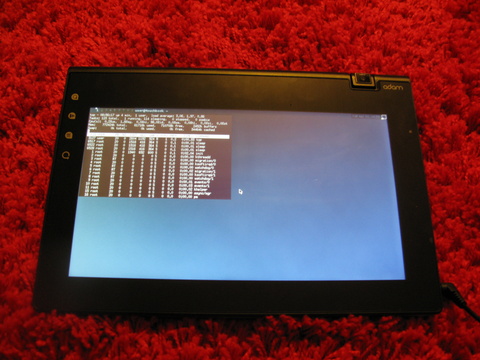putting debian on the notion ink adam
Sun, 01 May 2011 01:01 categories: debianIntroduction
I recently put Debian Sid on my Notion Ink Adam and since I wouldnt have managed to do that alone I want to thank the guys in ##adamroot on freenode - especially RaYmAn who initially assembled a boot.img to put ubuntu on the adam and also wrote the hack to use the multitouch touchscreen as singletouch. IntuitiveNipple was also very helpful and you should check out his great personal wiki.
Quick Solution
Just download my pre-assembled boot.img
You will flash it to the adam from your linux host with a proprietary tool called nvflash that you can grab here for your specific version of adam:
unzip it and find out the partition number you want to flash the image to. For each invocation of nvflash you have to put your adam into apx mode recovery by holding down the volume down button and the power button until the orange charge LED and the red CPU LED light up.
./nvflash --bl bootloader.bin --getpartitiontable parts.cfg
In parts.cfg the SOS partition is the recovery partition (most likely partition 8) and LNX is the boot partition (most likely partition 9). Flashing boot.img to the recovery partition will give dual boot capabilities but destroy the recovery image. Flashing it to the boot partition has the advantage that it boots per default. I flashed it to the boot partition which was partition 9 for me.
./nvflash --bl bootloader.bin --download 9 boot.img
Once that finished the adam can be switched off an on again. The adam will now boot some /sbin/init from the first partition on an SD card.
I prepared a debian rootfs you can just extract to your SD. It comes with e17 and you best select illume in the welcome screen: debian-sid-multistrap.tar.xz
The rootfs also includes the proprietary broadcom module and firmware for the bcm4329: modules.tar.gz
The rootfs was created using this script: rootstock.sh
Modifying boot.img
If you want to make changes to the boot.img (specifically recompile the kernel) it works the following:
To extract and create the boot.img use the android BootTools (local copy)
git clone https://github.com/AndroidRoot/BootTools.git
cd BootTools
make
With this tool you can already unpack the boot.img and look what's inside. The boot.img will unpack into a ramdisk and the kernel and a textfile that specifies additional parameters like the kernel cmdline arguments. The ramdisk can be examined and changed as usual with cpio.
./BootTools/bootunpack boot.img
gunzip boot.img-ramdisk.cpio.gz
mkdir ramdisk
cd ramdisk
cpio -id < ../boot.img-ramdisk.cpio
Ramdisk
The ramdisk is good for two things: work around the setfont bug and introduce a delay before the root partition from the SD is mounted. I tried to boot without a ramdisk, using the rootdelay kernel commandline option but it didnt work. I have no idea what is going wrong due to the setfont bug. This bug means that the framebuffer console will only output anything else than the initial blank, black screen when a KDFONTOP ioctl is done to one of the ttys.
The ramdisk contains an /init that mounts the root partition from the SD card after a delay of three seconds or falls back to a shell if there is no /sbin/init on it and statically compiled busybox and setfont. Setfont is a program that will do the ioctl and load the font Lat15-Fixed16 to the tty specified by its first command line argument. The sourcecode is included in the ramdisk itself as setfont.c.gz and can also be downloaded here: setfont.c.
Cross compiling a kernel for ARM
To compile the kernel you need a cross build toolchain that is easiest installed via the emdebian repository.
apt-get install emdebian-archive-keyring
echo deb http://www.emdebian.org/debian/ squeeze main >> /etc/apt/sources.list
apt-get update
apt-get install gcc-4.4-arm-linux-gnueabi
clone the notionink kernel sources:
git clone https://github.com/notionink/adam-kernel.git
put my config into it
curl http://mister-muffin.de/adam/config > adam-kernel/.config
the following patch will change the multitouch driver into a singletouch one that is supported by the current Xorg evdev driver and will also add the accept4 system call that is needed for udev >= 168.
cd adam-kernel
curl http://mister-muffin.de/adam/kernel.diff | git apply
build the thing
make ARCH=arm CROSS_COMPILE=arm-linux-gnueabi- -j5
create the boot.img from the new kernel and the ramdisk
./BootTools/mkbootimg --kernel adam-kernel/arch/arm/boot/zImage \
--ramdisk linux_boot.img-ramdisk.cpio.gz \
--cmdline 'mem=256M@0M nvmem=256M@256M mem=512M@512M vmalloc=384M video=tegra'\
'fb console=tty0,115200n8 usbcore.old_scheme_first=1 cpuid=200102 devicetype='\
'1002 tegraboot=nand mtdparts=tegra_nand:16384K@9984K(misc),16384K@26880K(rec'\
'overy),16384K@43776K(boot),204800K@60672K(system),781952K@266112K(cache) roo'\
't=/dev/mmcblk0p1 init=/sbin/init debug' --output boot_new.img
and upload it to the device as shown above
Device Specific Things
Input Devices
- /dev/input/event0 - hardware buttons
- /dev/input/event1 - capacitative buttons
- /dev/input/event2 - touchscreen
- /dev/input/event5 - accelerometer
the pixelqi display mode can be set with
/sys/devices/platform/pixel_qi_screen_ctrl/state
accelerometer is enabled with
/sys/devices/platform/accelerometer/enable
WWAN
the wwan card is a Ericsson F3307 and provides a cdc ethernet interface
chat -V ABORT "ERROR\r\n" "" \
"AT+CFUN=1" "OK\r\n" \
"AT+CGDCONT=1,"IP","$APN" "OK\r\n" \
"AT*ENAP=1,1" "OK\r\n" > /dev/ttyACM0 < /dev/ttyACM0
dhclient -v usb1
(notice that, depending on your provider you might not need to specify the APN - at least here in germany I didnt yet encounter a provider where you had to)
WLAN
wlan works as usual via wpa_supplicant
GPS
gps is /dev/ttyHS3 and outputs NMEA
Battery
/sys/devices/platform/smba10xx_battery/power_supply/battery/capacity
Not working
- alsa (no clue what's going on)
- camera (no v4l2 device in /dev)
- bluetooth (part of bcm wireless)
- fm-transceiver (part of bcm wireless)
- compass (needs memsic daemon running)
- cpu scaling (needs nvidia daemon)
